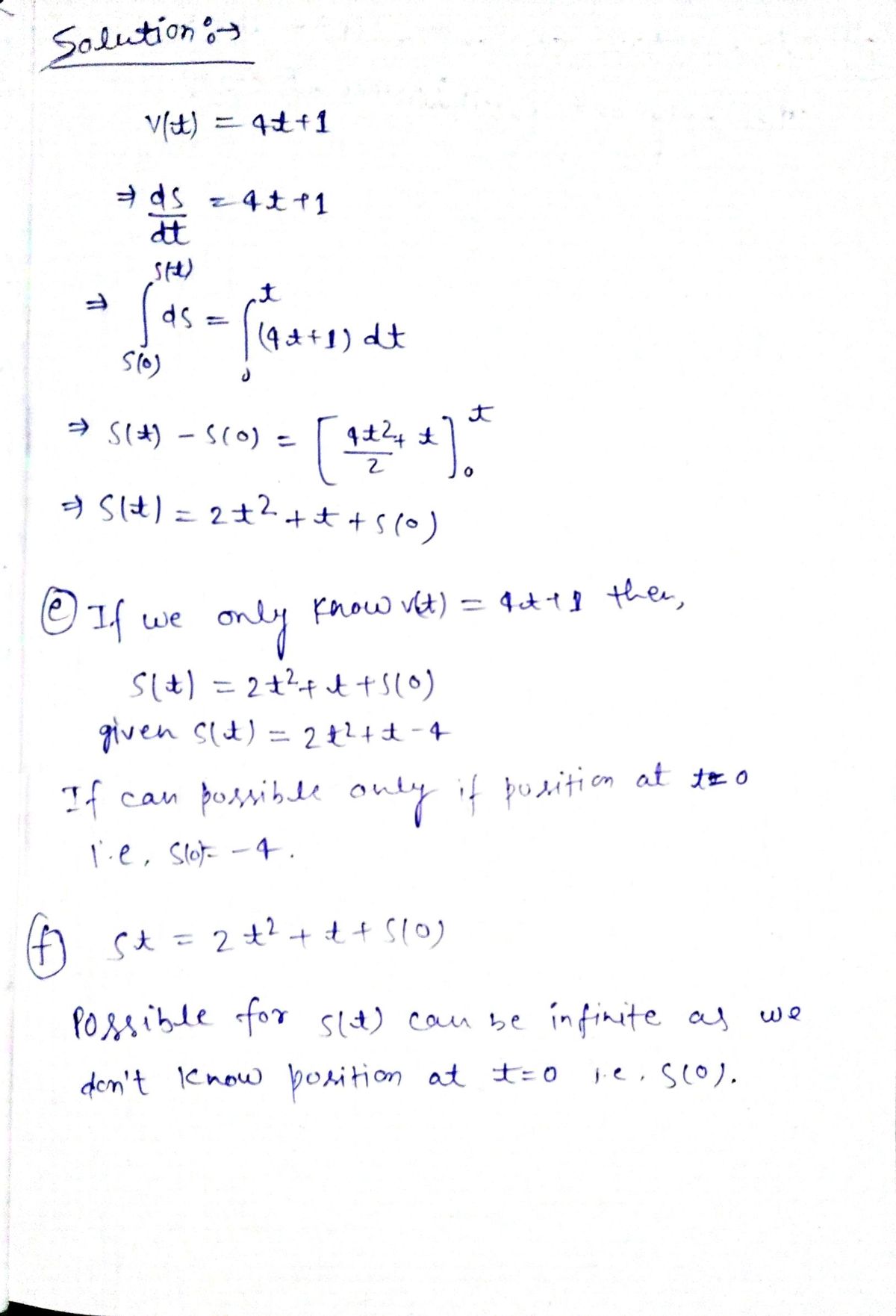Preview Activity 7.1.1. The position of a moving object is given by the function s(t), where s is measured in feet and t in seconds. We determine that the velocity is v(t) = 4t + 1 feet per second. a. How much does the position change over the time interval [0, 4]? b. Does this give you enough information to determine s(4), the position at time t = 4? If so, what is s(4)? If not, what additional information would you need to know to determine s(4)? c. Suppose you are told that the object's initial position s(0) = 7. Determine s(2), the object's position 2 seconds later. d. If you are told instead that the object's initial position is s(0) = 3, what is s(2)? e. If we only know the velocity v(t) = 4t + 1, is it possible that the object's position at all times is s(t) = 2t² + t − 4? Explain how you know. f. Are there other possibilities for s(t)? If so, what are they? g. If, in addition to knowing the velocity function is v(t) = 4t + 1, we know the initial position s(0), how many possibilities are there for s(t)?
Preview Activity 7.1.1. The position of a moving object is given by the function s(t), where s is measured in feet and t in seconds. We determine that the velocity is v(t) = 4t + 1 feet per second. a. How much does the position change over the time interval [0, 4]? b. Does this give you enough information to determine s(4), the position at time t = 4? If so, what is s(4)? If not, what additional information would you need to know to determine s(4)? c. Suppose you are told that the object's initial position s(0) = 7. Determine s(2), the object's position 2 seconds later. d. If you are told instead that the object's initial position is s(0) = 3, what is s(2)? e. If we only know the velocity v(t) = 4t + 1, is it possible that the object's position at all times is s(t) = 2t² + t − 4? Explain how you know. f. Are there other possibilities for s(t)? If so, what are they? g. If, in addition to knowing the velocity function is v(t) = 4t + 1, we know the initial position s(0), how many possibilities are there for s(t)?
Advanced Engineering Mathematics
10th Edition
ISBN:9780470458365
Author:Erwin Kreyszig
Publisher:Erwin Kreyszig
Chapter2: Second-order Linear Odes
Section: Chapter Questions
Problem 1RQ
Related questions
Question
Only need helps with parts e,f and g please, thank you!
![Preview Activity 7.1.1. The position of a moving object is given by the
function s(t), where s is measured in feet and t in seconds. We determine that
the velocity is v(t) = 4t + 1 feet per second.
a. How much does the position change over the time interval [0, 4]?
b. Does this give you enough information to determine s(4), the position at
time t
=
= 4? If so, what is s(4)? If not, what additional information would
you need to know to determine s(4)?
c. Suppose you are told that the object's initial position s(0) = 7. Determine
s(2), the object's position 2 seconds later.
d. If you are told instead that the object's initial position is s(0) = 3, what is
s(2)?
e. If we only know the velocity v(t) = 4t + 1, is it possible that the object's
position at all times is s(t) = 2t² + t − 4? Explain how you know.
f. Are there other possibilities for s(t)? If so, what are they?
g. If, in addition to knowing the velocity function is v(t) = 4t + 1, we know
the initial position s(0), how many possibilities are there for s(t)?](/v2/_next/image?url=https%3A%2F%2Fcontent.bartleby.com%2Fqna-images%2Fquestion%2Fce3589f0-5608-4fb5-a11c-ce1805f2c8e6%2Fa51e97f4-0ee1-4660-88f8-f4da24991ec6%2Fdlzdrfq_processed.png&w=3840&q=75)
Transcribed Image Text:Preview Activity 7.1.1. The position of a moving object is given by the
function s(t), where s is measured in feet and t in seconds. We determine that
the velocity is v(t) = 4t + 1 feet per second.
a. How much does the position change over the time interval [0, 4]?
b. Does this give you enough information to determine s(4), the position at
time t
=
= 4? If so, what is s(4)? If not, what additional information would
you need to know to determine s(4)?
c. Suppose you are told that the object's initial position s(0) = 7. Determine
s(2), the object's position 2 seconds later.
d. If you are told instead that the object's initial position is s(0) = 3, what is
s(2)?
e. If we only know the velocity v(t) = 4t + 1, is it possible that the object's
position at all times is s(t) = 2t² + t − 4? Explain how you know.
f. Are there other possibilities for s(t)? If so, what are they?
g. If, in addition to knowing the velocity function is v(t) = 4t + 1, we know
the initial position s(0), how many possibilities are there for s(t)?
Expert Solution
Step 1

Trending now
This is a popular solution!
Step by step
Solved in 2 steps with 2 images

Recommended textbooks for you

Advanced Engineering Mathematics
Advanced Math
ISBN:
9780470458365
Author:
Erwin Kreyszig
Publisher:
Wiley, John & Sons, Incorporated

Numerical Methods for Engineers
Advanced Math
ISBN:
9780073397924
Author:
Steven C. Chapra Dr., Raymond P. Canale
Publisher:
McGraw-Hill Education

Introductory Mathematics for Engineering Applicat…
Advanced Math
ISBN:
9781118141809
Author:
Nathan Klingbeil
Publisher:
WILEY

Advanced Engineering Mathematics
Advanced Math
ISBN:
9780470458365
Author:
Erwin Kreyszig
Publisher:
Wiley, John & Sons, Incorporated

Numerical Methods for Engineers
Advanced Math
ISBN:
9780073397924
Author:
Steven C. Chapra Dr., Raymond P. Canale
Publisher:
McGraw-Hill Education

Introductory Mathematics for Engineering Applicat…
Advanced Math
ISBN:
9781118141809
Author:
Nathan Klingbeil
Publisher:
WILEY

Mathematics For Machine Technology
Advanced Math
ISBN:
9781337798310
Author:
Peterson, John.
Publisher:
Cengage Learning,

